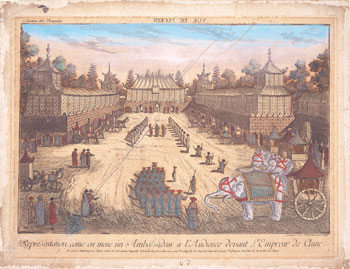Maggie Yu
Former Assistant Curator II (Historical Pictures), Hong Kong Museum of Art
2008

John Nieuhof (1618-1672) (drawn)
Franz Xaver Habermann (1721-1796) (engraved)
This is the scenery of the Chinese emperor receiving foreign diplomatic ambassador in his palace. Courtiers, troops and representative are entering the palace in a solemn ceremony. The procession at the bottom right hand corner pulled by white elephants could well be the Indian delegation. This art piece was painted by Dutch artist John Nieuhof (1618-1672) who visited China with the Dutch Ambassador to East Indian Company from 1655 to 1657. It was subsequently reproduced as "Optics picture" (Vue d 'Optique, means 'sights of Optics'). By this means the European were given the chance to peep into the mysterious Orient.
"Optics picture" is a form of specifically composed print in vogue in England and Europe from the late 18th century to early 19th century. It should be viewed with a specially designed device – the Zograscope – which creates an illusion of depth and three-dimensional effect with a series of reflecting mirrors. Prints like these are usually duplicates of works by travelling painters, with cityscapes around the world as subjects. Generally they are in strong perspective and composition, while heavy opaque colouring is used to enhance the stereoscopic effect. This imaginary travelogue satisfied the curiosity of Europeans at the time who had limited opportunities to travel and see the world. Their popularity is evident as they were discovered and collected from many different sources, from living rooms of rich family homes to "peepshows" in market fairs.



